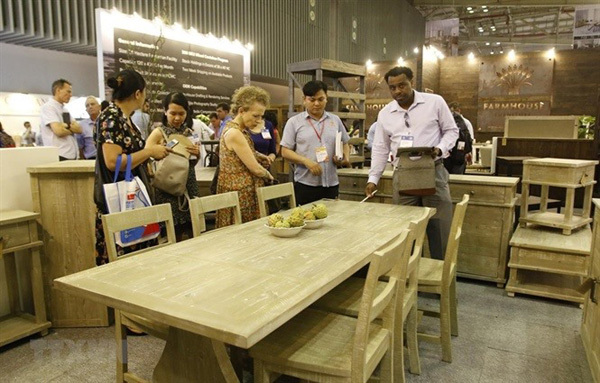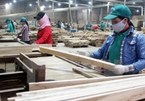 |
|
Foreign customers visit a furniture showroom.
|
Delegates at the "ASEAN Market Attraction" forum organised by Handicraft and Wood Industry Association of HCM City (HAWA) and the ASEAN Furniture Industry Council (AFIC) agreed that the region boasts many great advantages in terms of materials, production, design, distribution and market size in wood and furniture processing.
Last year, the countries in the region exported US$12.1 billion worth of wooden furniture out of the global total of $150 billion, with the US, Europe, Japan, Korea, and Canada being their main markets.
Nguyen Quoc Khanh, HAWA chairman, said Vietnam, Malaysia, Indonesia, Thailand, and the Philippines are fast growing furniture suppliers with two-thirds of their production prioritised for export.
Their export to production ratio is more than double the global average of around 30 per cent with Southeast Asia's wood and furniture exports meeting 5 per cent of demand in the US and 2 per cent in Western Europe, he said.
Nguyen Xuan Thuy, deputy director of the Ministry of Industry and Trade’s Industry Development Centre, said with a population of over 600 million, rapid economic growth and increasing income, Southeast Asia is a huge market with high demand and purchasing power.
“But intra-regional trade is still low compared to the potential. A lot of things are needed to improve [this].”
Khanh said: “While the ASEAN market is obviously large, the question is how to enable Vietnamese and regional enterprises to exploit that potential? The most convincing answer is creating a ‘Cooperation - Link – Alliance’ model between Vietnamese enterprises and between businesses and associations in the region.
“Vietnam's wood industry is leading the region in terms of potential, but most businesses only focus on their own interests, brands and products without seeing the great benefits of building an industry brand.
“ASEAN countries compete with each other. Therefore, a larger common goal is needed to create cohesion, consensus and co-operation for mutual prosperity.
“A combination of everyone’s strengths and alliances with regional partners will create a value chain in the wood industry.”
Co-operation in the regional wood industry should be based on the potential of countries and the strategy of enterprises, he said.
There should be vertical links between strong producers like Vietnam, Indonesia, Laos, and Myanmar and those strong in trade, design and services like Thailand, Singapore, Malaysia, and the Philippines, he said.
The horizontal links should be between AFIC member associations in strategic orientations and alliances for sustainable development of the industry, he said.
With the impact of the US-China trade war, many buyers have shifted their orders from China to Southeast Asia.
In the first seven months of this year, Chinese wooden furniture and furniture exports to the US fell by 18.3 per cent year-on-year to $14.3 billion.
Khanh said: “Most US and European customers want to source goods from outside China, and this is a great opportunity for AFIC to have a common vision and undertake activities to seize this valuable opportunity and enhance the position of the region.
“We should link to supplement each other and become stronger to counterbalance and compete in other production markets such as China and Europe.”
Emmanuel Padiernos, president of AFIC, said in addition to gathering twice a year, “We have started organising trade missions to each other countries. I think trade missions play a very important role in developing intra-ASEAN trade across different segments.”
Delegates also suggested that Vietnamese and ASEAN businesses should embrace digital transformation to better meet customers’ demands and promote consumption of their products since customer buying behaviours and expectations have changed dramatically.
Tran Viet Tien of HAWA said the ASEAN wood industry has been responding positively to changes in global markets by introducing national mechanisms and policies and changes in business and production activities at the enterprise level.
“The highest and consistent goal of the ASEAN Market Attraction forum is to promote and support links between Vietnamese enterprises and between regional enterprises and alliances between member associations for a prosperous and sustainable ASEAN wood industry.” VNS

Local wood exporters eye domestic market
With the upcoming entrance of global home furnishing brand Ikea into the Vietnamese market, many large local wood exporters are paying more attention to the domestic market.

Vietnam’s wood industry struggle to prevent trade fraud
According to a market research by Forest Trend, in the first five months of this year, the number of new FDI projects in wood industry totaled 49 projects, of which there were 32 projects belonging to wood processing field.

Vietnamese woodworking firms increase investment in technology, machinery
Nguyen Phuong, sales director of Minh Thanh Co., Ltd, said his company plans to invest more than 50 billion VND (2.15 million USD) in a production chain for bedroom and living room furniture.
 Furniture companies and industries in Southeast Asia should pool their strengths and enhance co-operation to achieve prosperity and sustainability, a forum heard in HCM City on Wednesday." itemprop="description" />
Furniture companies and industries in Southeast Asia should pool their strengths and enhance co-operation to achieve prosperity and sustainability, a forum heard in HCM City on Wednesday." itemprop="description" />